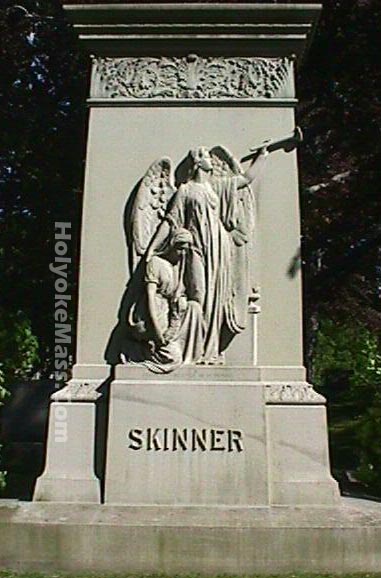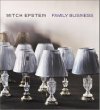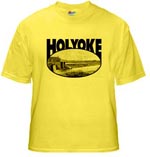by Laurel | February 28th, 2013
March 1, 1902
A Leading Citizen of Holyoke
His Successful Career as a Manufacturer, and His Generous, Helpful Life
William Skinner, 78, the well-known manufacturer of Holyoke, died yesterday afternoon about 2:30 at his home on Pine Street. The shock of the death of Mr. Skinner was in some measure lessened to the public at large by the fact that through the weakness of old age and his failing health he had been removed for a number of months from public sight.
Nevertheless, among those up and down the valley who have kept in touch with Holyoke affairs, as well as his innumerable friends and acquaintances in the various walks of life and throughout the industrial and financial interests he touched at so many points, there will be deep and genuine sorrow to learn of his taking away. To sum up in detail what the life of William Skinner has meant to Holyoke in its broadest sense would take wide space than newspaper limits allow. A few brief sentences may be helpful in indicating the range of the activities of this busy life, with its broad human sympathy, and in summarizing the most striking features of a rugged personality that gave him the title of the “Old Roman” to a few of his choicest friends. The impress of his personality on Holyoke and Holyoke institutions will not soon be forgotten, nor is it likely to be passed over lightly by historians. Holyoke’s men and women will long remember the vast good that has been done by him in all lines of charity, benevolence and philanthropy. His was a fine, simple life, honest and impeccable, and his integrity was never questioned. His success in business was the natural result of his sagacity and diligence, and his career may be studied with profit by all.
Much has been made of his larger gifts — to the Young Men’s Christian Association, to the city hospital, to the Northfield schools, to the city library, and other institutions Yet it is to be doubted if the sum total of his gifts would show as large an amount of money bestowed upon these larger objects as the total gifts here and there to the poor, to the needy, the weak, and the struggling, wherever circumstances made it possible for him to lend the helping hand. To William Skinner it was a joy to give — not indiscriminately, but carefully and wisely, and quietly, obeying the literal truth the injunction not to let one hand know what the other doeth. Instance after instance has come to light through others in years past of sympathy and help at the right time to those who were deserving, though unfortunate, to some struggling young man or woman, to worthy employees suffering from a long illness, to those injured in his employ, to the unfortunate of all classes for his sympathies were broad and catholic, free and inclusive. In Holyoke there are many records of his munificent philanthropy, but none perhaps will more lasting redound to his credit than the establishment of the city hospital, which was for years his pride, and when failing health forced him to relinquish many of the active duties of life, one of the hardest things to give up, perhaps, next to the manufacturing plant which his brains and energy had created, was his personal attention to the interests of the city hospital.
In his business dealings with men there was always that fine essence of sterling truth and candor — the trait of genuineness — that was reflected in his business transactions, even in the goods he sold. “Skinner’s silks” have become a mercantile synonym for a standard excellence in silks, for being just what they purport to be, without sham or shoddy or flimsy imitation of other than they pretend to be. It was this quality of goods that insured the great growth of business In 1894 the company employed 450 hands. As soon as the looms are running in the present enlarged No. 1 Mill there will be 900 employed.
In politics he was an independent democrat, though a strong tariff man, but in other respects a loyal member of the democracy, and for many years contributing largely to the local campaign funds. In the fall of 1898 a movement gained ground to nominate him for the mayoralty. But the political horizon was angry with the wrath of the people at the maladministration that had gone before; party feeling ran high, and the attempt to stem the partisan tide met with but moderate success, It would even then without doubt have been ultimately successful if his family had not importuned him to withdraw from political considerations. His health at that time was not strong; the burden of the city’s business was greater than perhaps even he appreciated, and the seemingly hopeless task of straightening out the civic tangles devolved upon others. Doubtless the work and the worry of the mayoralty would have shortened his days very materially, and the result was thus a blessing to him, but it is a pity that at an earlier time he never was called to the chair he was so eminently qualified to fill, and that the city had not had the benefit of his sagacity in business in the times when that quality was sadly lacking.
The pluck of the man was shown in his great disaster in the Mill River Valley. The 16th of May, 1874, was a day the horror of which is yet felt among those whose homes and interests lay in the path of the giant torrent released by the breaking of the Williamsburg dam. Among the other buildings that were swept away was the silk mill of William Skinner in Skinnerville, the last operative leaving about 30 seconds before the flood. Mr. Skinner’s house lay in the path of the torrent, but not in its full sweep, being only in part submerged. When later he decided to relocate in Holyoke and the walls of his factory had begun to rise, he had this old Williamsburg home taken apart, shipped on the cars to Holyoke and reset upon the magnificent Pine Street site, and it forms today the major part of the Skinner residence. The house has been added to and modified as time and occasion demanded — less so than the “wonderful one-horse shay” as a great part of the original residence is yet intact. This was in 1874, and but a few houses were in that locality, which considered to be way out in the suburbs.
William Skinner was born in England in 1824, his father being a dyer in a dye-house in London. After he had received his early schooling he went to work for his father to learn the dyeing business. The dye-house was owned by a man named Valentine, who had a son who came to Florence in this state to start a dyeing establishment. He soon sent to England for a foreman to take charge of his place at Florence, and young Skinner was sent over for that purpose. Young Valentine failed after a time, and William Skinner took the dye-house to satisfy a claim that he had against him. This was really the beginnings of a big Northampton industry, for out of it grew the Nonotuck Silk Company. For several years he ran the dye-house, dyeing the silk used for a number of small mills n Connecticut. About 1848, with Joseph Warner of Northampton, he embarked upon a new venture, that of making sewing silk, and the two had charge of a large plant. His first wife was a sister of Mr. Warner, but she lived less than two years. The partnership with Mr. Warner was short, and Mr. Skinner next bought land and built a mill between Haydenville and Williamsburg, later known as Skinnerville. He built a number of homes for his employees, and quite a thriving little settlement was established. The mill was of wooden construction, about 100 feet long, four stories high, and employed between 150 and 200 hands. He built a fine residence, and offices were opened in New York City and other cities for the sale of the Skinner goods. The great flood of 1874 completely wrecked the little hamlet, with its one industry, and he was forced to look elsewhere for a new site and to begin all over again.
The Holyoke Water-Power Company gave him a large lot on which to build if he would erect a house there, and the Williamsburg residence was accordingly moved down in sections, as noted above. He had paid up all his bills, and his credit was first-class, so he had little difficulty in securing favorable terms from the Holyoke Water-Power Company, and built a mill that cost perhaps $50,000, which has since been repeatedly enlarged, and about 1896 a second mill building on Bond Street was erected. The name of the firm was changed in 1883 to William Skinner & Sons and later to the William Skinner Manufacturing Company.
Mr. Skinner married for his second wife Miss Sarah E. Allen, daughter of Capt. Joseph Allen of Northampton. She survives him with seven children, Mrs. F. H. Warner of Boston, Mrs. Charles E. Clark of Philadelphia, Mrs. William H. Hubbard of Auburn, N.Y., William Skinner, Jr., and Belle, Katharine and Joseph, all of Holyoke.
Mr. Skinner had given so many large amounts to charitable and benevolent objects that it is impossible to enumerate all. In Holyoke to every public institutions he had been a liberal giver, and the name of William Skinner has been attached to many other good works, He was a large contributor to the fine Young Men’s Christian Association building in 1892, he was the founder and one of the heaviest contributors to the city hospital built in 1894, and its president until he resigned on account of ill health in 1900, and his latest gift of $10,000 so that the new public library building might be an accomplished fact is still remembered gratefully by the citizens at large. He was a trustee of Mount Holyoke College and of the Northfield Seminary, being especially interested in the latter. His interest was of the helpful sort, as his gift of the fine gymnasium to the school attests, In the business life of Holyoke and beyond even, he was prominent, being a director in the West End Street Railway Company of Boston, president of the People’s Savings Bank and vice-president of the Hadley Falls National Bank among other offices of trust.
The funeral will be held Monday afternoon at the Second Congregational Church at 2:30, and burial will be private.
Adapted from The Springfield Republican.











My brother, who lives in Chicago, visited Wistariahurst with me on Sunday. We got a fine tour from a knowledgeable guide. Those who have not been there yet should visit.